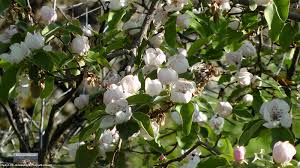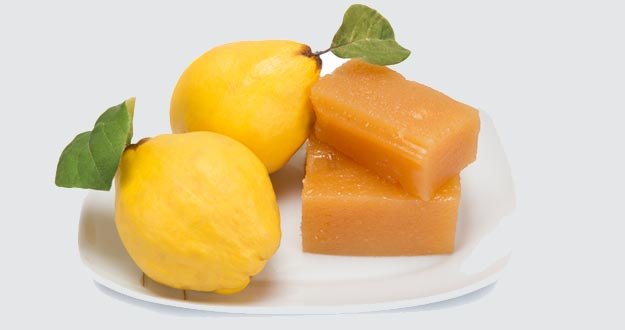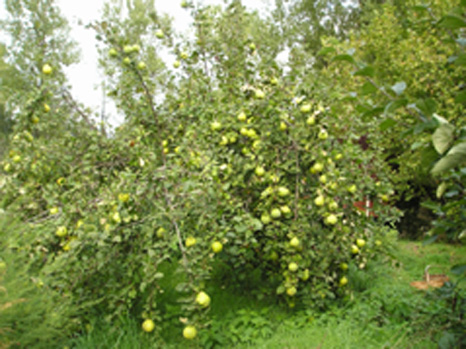Autumn is a time of quince and formerly it was made slow cooked.
The quince is rich in fiber and potassium, so it is very healthy.
Spain, with 15 million kilos, is one of the leading European producers.
Extremadura, Andalusia and La Mancha are large producing Communities.
Note: Now, please click on "El sol del membrillo"
Indeed, with the Autumn arrive quinces. I do not mean to a Victor Erice's film, "El sol del membrillo" (“The sun of the quince”), about the pictorial art of Antonio Lopez (one of the best realist painters, that we have in Spain). No, I am neither referring to the smaller town of Toledo, called "Quince", located a few kilometers from Talavera de la Reina. No, I mean a product more modest, but essential in our Mediterranean cuisine: the quince.
The quince is the fruit of the quince tree, a tree in the rose family, that grows in cold and temperate climates. Its fruit is pear-shaped yellowish-green color, with a thick skin and covered by a grayish hairiness, which is lost when it matures in autumn.
The flesh is hard and sour, even when the fruit is ripe, but very aromatic. Its flowers are white or pink and appear in spring. They are white or pink, with five petals.

White flowers of a quince tree
In Spain there are a thousand acres under cultivation, all irrigated. The number of trees scattered exceed 62,000. We are large producers, with 15 million kilos, according to the latest data from the Ministry of Agriculture for the year 2009.
Extremadura, Andalucia, Castilla La Mancha, Catalonia and Murcia are the major producing regions. The absence of EU support and, above all, the high cost of sugar are affecting the decline of this farming, that we should recover in our diet.
The quince paste contains a high sugar content and therefore high caloric. Every 100 grams of quince paste contain 230 kilocalories. For sure, no cholesterol.

Two quinces and a piece of quince paste
Nutritional content of vitamins and minerals include, just except discrete quantities of potassium and vitamin C. Potassium is a mineral necessary for the generation and transmission of nerve impulses and normal muscle activity. Further it takes part in the balance of water inside and outside the cell.
Quince healthy properties are due to its abundance of fiber (pectin and mucilage) and tannins, substances that give it its astringent property par excellence.
It is also rich in malic acid, which provides the characteristic flavor of quince. This acid has disinfectant properties and promotes the elimination of uric acid. Finally, it brings polyphenols with antioxidant properties that prevent cellular aging.
The quince tree was cultivated since ancient Babylon, about 4,000 years before Christ. There are those who argue that the 'mysterious fruit of Eden' was not an apple, but a golden quince. As allegory of sin, it is not bad. Appetizing and appealing, it leaves a bitter taste if you eat it raw.

Un membrillero (a quince tree)
In ancient Greece, in the Cydonia region, on the island of Crete, the quinces or apples of Cydonia, were offered to Aphrodite, goddess of love, as a symbol of passion and fertility. This fruit also had a special meaning for the recently married, who had biting one before entering the bridal chamber.
According to Plutarch, Greek brides bited a quince sweeter than the present to perfume her mouth; so, that first kiss would not be unpleasant.
The Romans continued this tradition and left us recipes roasted quince with honey, sugar substitute, that they did not know. In the Middle Ages was a delicious ambrosia for kings and nobles. The Arabs used it as medicine greatly appreciated.
The Spanish people introduced the quince in America, from where sugar came to us, essential to make the quince paste. Uruguay and Chile stand out for their quinces sweeter.
“What is now known as 'quince paste' is very close to my childhood memories in Adrada, a town of Avila. It was the early 60s. At that time we children did not have 'playstation' , either could dream of a computer or 3D virtual sets. Everything was much simpler. I especially remember the smells and tastes of those years. Especially cabinets intense perfumed by the scent of quince.
The kitchen was magical, closed shop, where only women could access. A surprise for me was how to pout and pileup meantime tasty sweet could be achieved as the quince. We called it so. And unlike now, 'quince paste' or 'quince meat' ”.
"It is a matter of arms and patience," said my grandmother, as she prepared to fire the sweet delicious, passing from yellow to darker color by a process that seemed almost miraculous to me, a mystery most of my childhood, that I was discovering, little by little, as I was getting older”.
Quince is used practically everything. And until you can make a drink, that was the delight of our ancestors.
This is a recipe from "Sweet quince" (or “Quince paste”):
A kilo of quinces, previously boiled and cut so as to manipulate them better.
Sugar, 750 grams.
Two Pippin apple.
A carrot.
Preparation:
We grind all until a mush. Then we begin the most delicate phase. The cooking, and simmer, stirring a time, being careful with splatters. So we will avoid nasty burns.
As my grandmother said, it is "a matter of arms and patience." And after about half an hour, the quince is almost ready. We know it if we leave a spoon in the center and it is not moving. Let cool, always covered. Then molds and cold and retain the quince in the refrigerator. Watch and check. You will not regret. It is a pleasure for gods.
I hope that you test it.
Till soon, kind regards,
Luis.
Sponsored by Costaluz Lawyers.
Please click down here:
